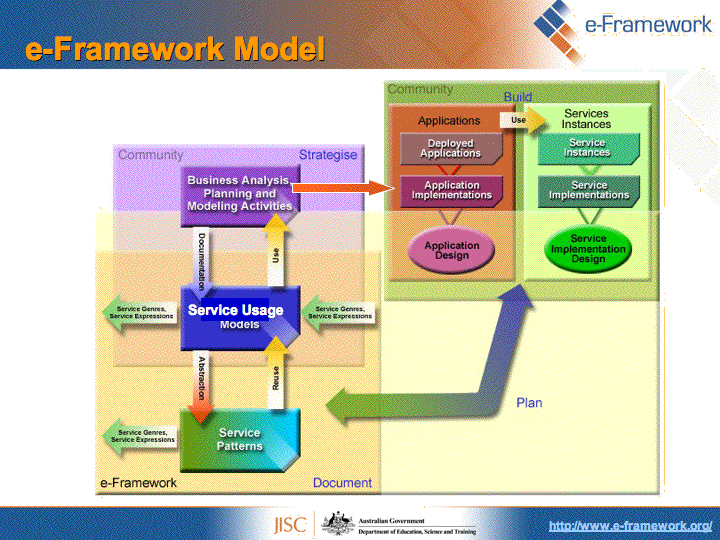E-framework: Difference between revisions
m (→Definition) |
|||
| Line 6: | Line 6: | ||
'''e-Framework''' has been developed to {{quotation | to facilitate technical interoperability within and acress educationa and research through improved stategic planning and implementation processes}} ([http://adlaustralia.org/idea2006/presentations/idea%20ef%2020061011.htm Daniel R. Rehak], retrieved 09:30, 24 April 2007 (MEST)). | '''e-Framework''' has been developed to {{quotation | to facilitate technical interoperability within and acress educationa and research through improved stategic planning and implementation processes}} ([http://adlaustralia.org/idea2006/presentations/idea%20ef%2020061011.htm Daniel R. Rehak], retrieved 09:30, 24 April 2007 (MEST)). | ||
This project could be considered one of the initiatives that will lead to future [[learning mangement system]]s. A connected, but somewhat different approach can be found so-called [[personal learning environment]]s. | |||
== Architecture of the framework == | == Architecture of the framework == | ||
Revision as of 10:37, 26 April 2007
This article or section is currently under construction
In principle, someone is working on it and there should be a better version in a not so distant future.
If you want to modify this page, please discuss it with the person working on it (see the "history")
Definition
“The e-Framework for Education and Research is an initiative by the UK's Joint Information Systems Committee (JISC) and Australia's Department of Education, Science and Training (DEST). The primary goal of the e-Framework is to facilitate technical interoperability within and across education and research through improved strategic planning and implementation processes.” (e-framework.org home page, retrieved 12:29, 24 April 2007 (MEST)).
e-Framework has been developed to “to facilitate technical interoperability within and acress educationa and research through improved stategic planning and implementation processes” (Daniel R. Rehak, retrieved 09:30, 24 April 2007 (MEST)).
This project could be considered one of the initiatives that will lead to future learning mangement systems. A connected, but somewhat different approach can be found so-called personal learning environments.
Architecture of the framework
e-Framework is a web service-oriented approach. Instead of one big application there are lots of services that can be integrated. A service, therefore, is not just built for a single system, but it can be re-used by others.
Here is a picture from a D.R Rehak talk about the core technical components of the e-Framework:
The e-Framework knowledge base
http://www.e-framework.org/ contains a knowledge base about the e-Framework and community-contributed components.
The e-Framework is documented in different ways:
- Non technically - what a service does
- Technically - how to write an service
- How to combine services
- Details models and workflows
These entries are not formal design specifications, but a place where developers can share intelligence and software.
e-FrameWork components
The e-framework is documented by Services, Service Usage Models and Guides
- (1) Services
Within the e-Framework, it is used in the sense of a technical service that promotes interoperability between systems ([1]). It relies on a number of web technologies: service-oriented approaches (soa), Service-oriented architectures (SOA) and web services.
Services are categorized by genres, e.g. something like: query, chat, simulate, resolve, authenticate. This genres are defined by 16 elements:
- Required: name, classification, version, description, functionality
- Recommended: behaviours & requests, use & interactions
- Optional: usage scenarios, applicability, structure, applicable standards, design decisions & tradeoffs, implementation guidance & dependencies, known uses, related service usage models, related core SUMs.
- (2) Service Usage Models
“SUMs provide a description of the needs, requirements, workflows, management policies and processes within a domain and the mapping of these to a design of a structured collection of Service Genres and Service Expressions, resources, associated standards, specifications, data formats, protocols, bindings, etc., that can be used to implement software applications within the domain. In other words, SUMs model how services meet business needs.” ([2], retrieved 12:29, 24 April 2007 (MEST)]).
- (3) Guides
Explain contributors to the framework how to write and submit documents with Service Genre descriptions, Service Expression descriptions and Service Usage Models, etc.
Links
- Players
- e-framework.org. The e-Framework for Education and Research is an initiative by the UK's Joint Information Systems Committee (JISC) and Australia's Department of Education, Science and Training (DEST)
- Introductions
- Introducing The Service Oriented Approach (Movies).
- The core technical components of the e-Framework Slides by Daniel R. Rehak, Idea 2006.
